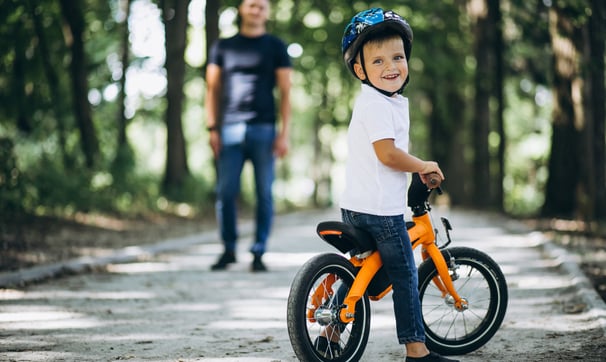"Pedaling Towards the Future!
YOUNG RIDERS


Young riders require your assistance and praise until they take their first pedals. Then they are free!
I want to talk about this process from the perspective of an instructor and young rider who is starting the journey into the cycling world. In addition to this how basic, minimal training can give young riders the skills to begin to make their own decisions that can grow into wider more important choices.
Each of these steps we will cover take understanding and experience to get right. If you can communicate with young riders and be understanding, you can inspire even the shyest young riders
#1 Give them the choice.
So, this is often taken away from the young rider by their parents/guardians. They may not want to be riding at all, so the best course of action is to take a friendly approach and explain how fun and exciting cycling can be. Sometimes riders cannot balance totally and may need more assistance. A great technique is to hold onto the shoulders of the young rider in turn, keeping them supported. More capable young riders will often be happy to show you how well they can ride a bike. The trick is to set out parameters for the riders, like a circuit of cones to follow in a path.
#2 Teach them the basics.
Once you have established the abilities of the young riders, you can tailor your session to suit what outcome you think is most likely. If the young riders are ready, consider following the BIKEABILITY basic skills CHECK, LOOK, MOOVE, COMMUNICATE, and RIDE. You can find these skills on the BIKEABILITY website. Now is when you want to teach the young riders to be aware of their surroundings, how to keep control of their bike, how to pedal effectively and efficiently, and how to glide to a stop while using the brakes. These skills are the basics, and a young rider should consistently perform these to progress to the next level, riding on the roads.
#3 Take them out onto suitable roads.
So, we are looking to challenge the young riders that make it this far, but we need to think progressively in our approach. Starting and stopping may seem like a super, simple, and easy task for us. But for a young rider that has never ridden on the road previously, it can be daunting and frightening, so bear this in mind with your approach to the life skills you are about to instill in them.
#4 Empower them to make the correct decision.
Have the young riders help with choices and decisions, they will be riding on the roads without you, so it makes sense they should be aware of the decisions they are required to take when the time comes. Young riders will need reminding of certain aspects of the lessons, so try and have them use their brains and ask if they feel they need to change anything or add anything to their riding.
#5 Support them and discuss their riding.
Giving a young rider support can be as simple as a thumbs up after completing a task correctly. Some young riders need a lot more than that, you need to make that decision, but ultimately it comes down to how humans respond to praise. Another great tool is feedback. Having a young rider assess and give feedback to another young rider is extremely powerful. So, if you have a group utilizing this, you’ll be surprised at how well it works.
#6 Continue to support and challenge them.
By now, the young riders will have a good grasp on what it takes to ride on a road confidently, so use their newly found confidence and challenge them to talk through what they are doing as they do it. Like when they approach a junction and want to turn across oncoming traffic, have them explain the process to you as you ride behind them. You can challenge them on busier roads and junctions, which can require a lot of prep work to build up to it; Alternatively, riding as a pair will relieve most of the stresses on the young rider. You can guide them through busier sections helping to build on that all-important confidence and life skills training.
M Callaghan